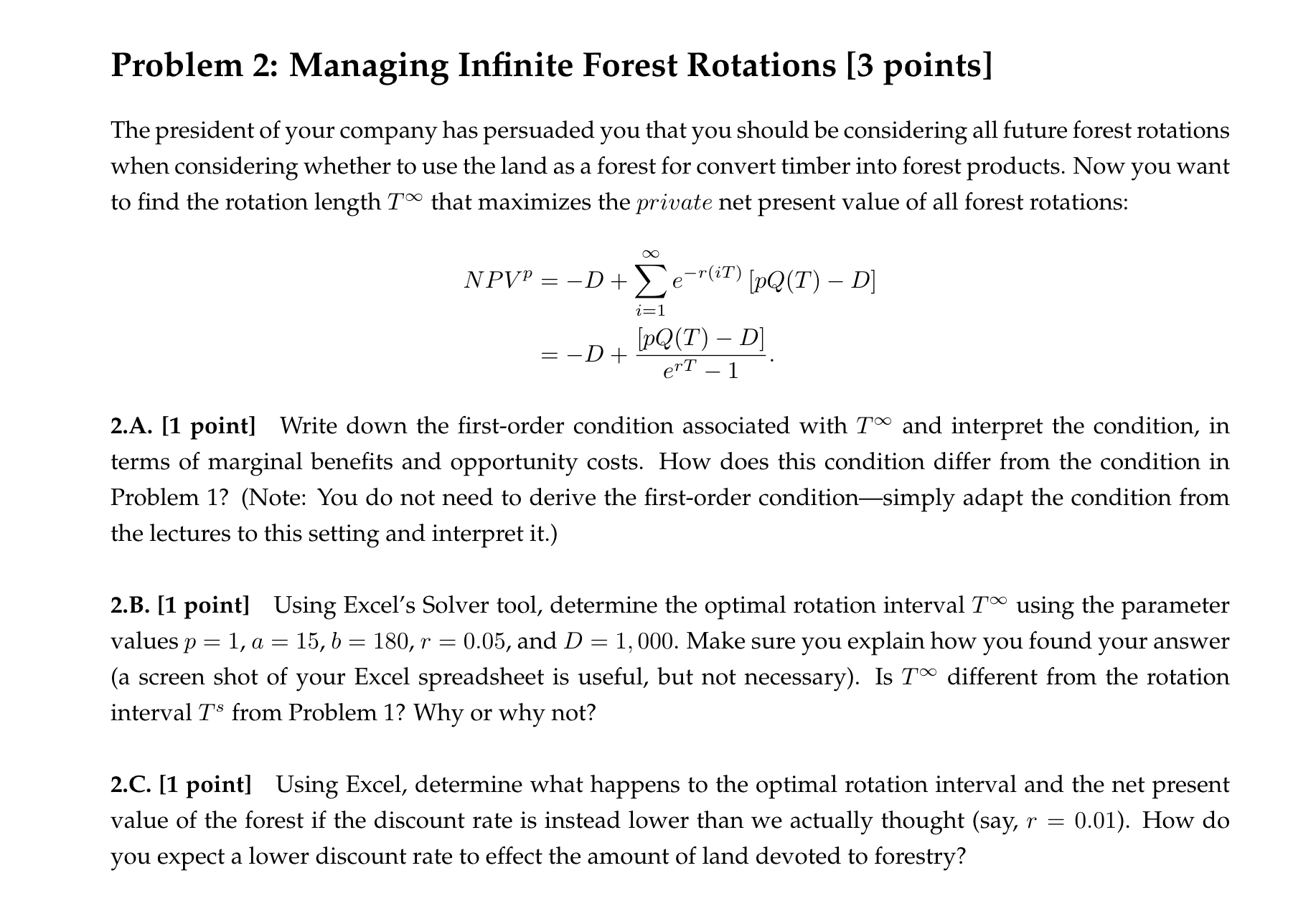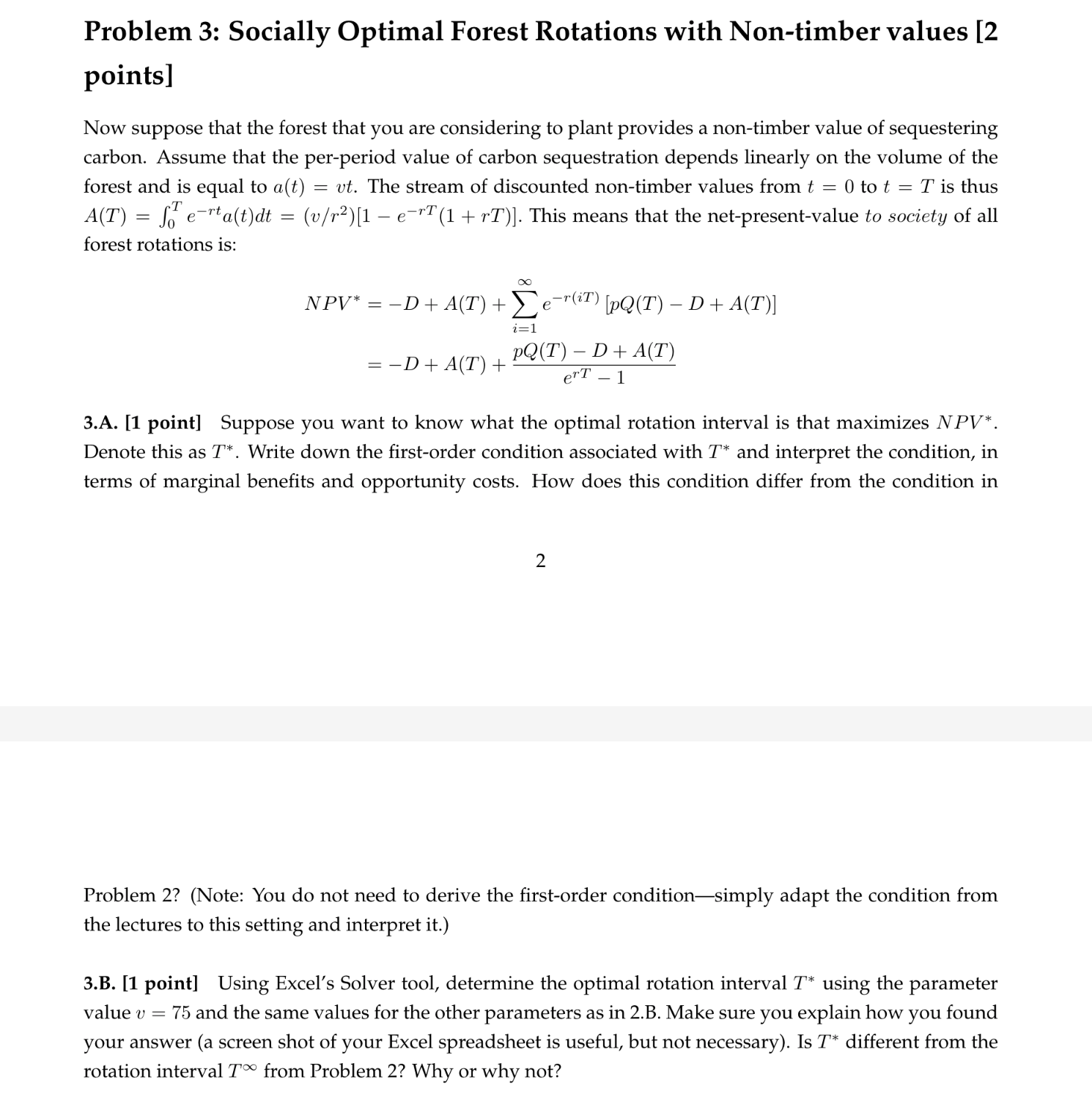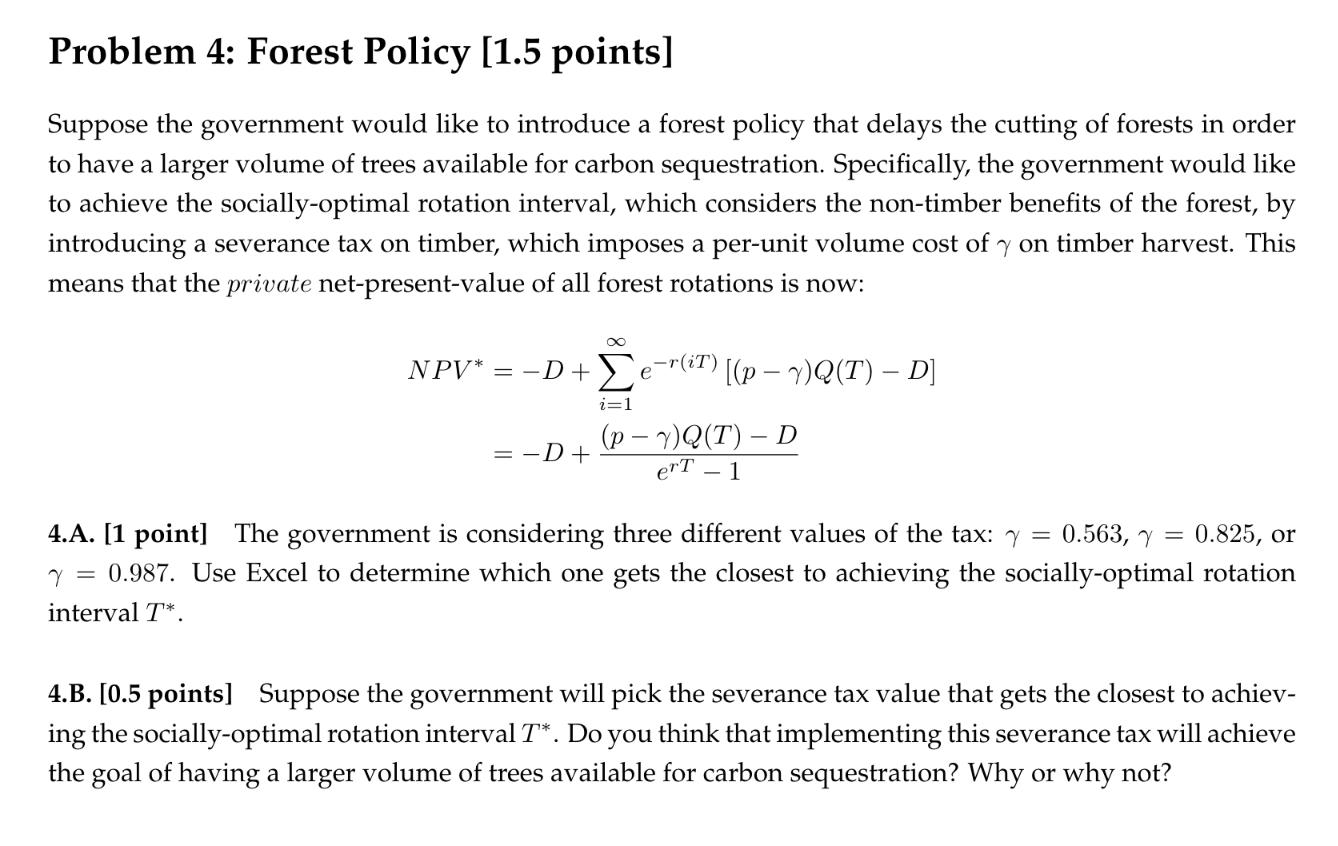Please answer these questions.
Problem 2: Managing Innite Forest Rotations [3 points] The president of your company has persuaded you that you should be considering all future forest rotations when considering whether to use the land as a forest for convert timber into forest products. Now you want to find the rotation length T"O that maximizes the private net present value of all forest rotations: NPVP : D :0: (WW) [pQ(T) D] il _ [5cm D]_ eTl :D 2.A. [1 point] Write down the first-order condition associated with T00 and interpret the condition, in terms of marginal benefits and opportunity costs. How does this condition differ from the condition in Problem 1? (Note: You do not need to derive the first-order conditionsimply adapt the condition from the lectures to this setting and interpret it.) 2.B. [1 point] Using Excel's Solver tool, determine the optimal rotation interval T00 using the parameter values p = 1, a = 15, b = 180, r = 0.05, and D = 1,000. Make sure you explain how you found your answer (a screen shot of your Excel spreadsheet is useful, but not necessary). Is T different from the rotation interval T5 from Problem 1? Why or why not? 2.C. [1 point] Using Excel, determine what happens to the optimal rotation interval and the net present value of the forest if the discount rate is instead lower than we actually thought (say, 7' : 0.01). How do you expect a lower discount rate to effect the amount of land devoted to forestry? Problem 3: Socially Optimal Forest Rotations with Non-timber values [2 points] Now suppose that the forest that you are considering to plant provides a non-timber value of sequestering carbon. Assume that the per-period value of carbon sequestration depends linearly on the volume of the forest and is equal to a(t) 2 at. The stream of discounted non-timber values from t = 0 to t = T is thus A(T) : f: e'\"a(t]dt : (v/r2)[l e_'"T(1 + rT)]. This means that the net-present-value to society of all forest rotations is: NPW : _D + AU") + i ero'T) [me D + MN m D + Am =D AT + ()+ erT_1 3.A. [1 point] Suppose you want to know what the optimal rotation interval is that maximizes N PV\". Denote this as T\". Write down the first-order condition associated with T\" and interpret the condition, in terms of marginal benets and opportunity costs. How does this condition differ from the condition in Problem 2? (Note: You do not need to derive the rst-order conditionsimply adapt the condition from the lectures to this setting and interpret it.) 3.3. [1 point] Using Excel's Solver tool, determine the optimal rotation interval T\" using the parameter value v = 75 and the same values for the other parameters as in 2.3. Make sure you explain how you found your answer (a screen shot of your Excel spreadsheet is useful, but not necessary). Is T* different from the rotation interval T\" from Problem 2? Why or why not? Problem 4: Forest Policy [1.5 points] Suppose the government would like to introduce a forest policy that delays the cutting of forests in order to have a larger volume of trees available for carbon sequestration. Specifically, the government would like to achieve the sociallyoptimal rotation interval, which considers the non-timber benets of the forest, by introducing a severance tax on timber, which imposes a perunit volume cost of qr on timber harvest. This means that the private netpresentvalue of all forest rotations is now: pr : D + f e-W'T) [(p was\") D] 12:1 T D D+'P 335933 4.A. [1 point] The government is considering three different values of the tax: 7 = 0.563, 7 = 0.825, or 7 = 0.987. Use Excel to determine which one gets the closest to achieving the socially-optimal rotation interval T\". 4.3. [0.5 points] Suppose the government will pick the severance tax value that gets the closest to achiev- ing the socially-optimal rotation interval T* . Do you think that implementing this severance tax will achieve the goal of having a larger volume of trees available for carbon sequestration? Why or why not? Problem 1: Managing a Single Forest Rotation [3.5 points] You are the manager of a forest products company and you are considering whether to plant your land with a slow-growing species of tree. The harvestable volume of timber for a rotation length of T > 0 is Q(T) = ea'b/T. Suppose that you incur a fixed cost of D at the beginning of a rotation (e.g., converting/ clearing the land, planting the trees, etc}. Let p be the net benet per-unit volume of the forest (i.e., the price per- unit volume of the harvested forest minus the cost per-unit volume of harvesting), which is assumed to be constant over time. Thus, you will receive (discounted) prots equal to 11 = e'TTpQ(T) D for a rotation length of T, where r is your discount rate. LA. [1 point] Suppose that you wish to maximize the average annual yield (or the mean annual incre- ment) from a rotation length T. What rotation length maximizes the mean annual increment? What is the associated volume? Be sure to show your work. Hint 1: Your answers will not be numbers, they will be functions of the parameters. Hint 2: The derivative of 6ft\") with respect to a: is equal to f '(x)ef (m). LB. [1 point] Now suppose that you want to choose a rotation length that maximizes the discounted prof- its associated with a single rotation. Denote this rotation length as T3. Write down the firstorder condition associated with respect to T9 and interpret what the condition means, in terms of marginal benefits and opportunity costs. Then solve for the rotation length T5 (as a function of parameters). LC. [0.75 points] Now that you've determined the optimal rotation length for a single rotation, you need to decide whether it's worth using the land to grow a forest. Write down the condition that must hold for using the land as a forest to be worthwhile. LD. [0.75 points} Suppose you have the following parameter values: p : 1, a : 15, b : 180, r : 0.05, and D = 1, 000. What is the optimal optimal single rotation length Ts? Is it worth using the land to grow a forest










